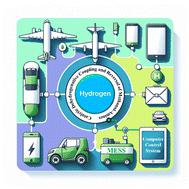当前位置:
X-MOL 学术
›
Chem. Commun.
›
论文详情
Our official English website, www.x-mol.net, welcomes your feedback! (Note: you will need to create a separate account there.)
Catalytic dehydrogenative coupling and reversal of methanol–amines: advances and prospects
Chemical Communications ( IF 4.9 ) Pub Date : 2024-03-20 , DOI: 10.1039/d4cc00653d Yujing Zhang 1 , Xiaomei Yang 1 , Shimin Liu 2 , Jiacheng Liu 1 , Shaofeng Pang 3
Chemical Communications ( IF 4.9 ) Pub Date : 2024-03-20 , DOI: 10.1039/d4cc00653d Yujing Zhang 1 , Xiaomei Yang 1 , Shimin Liu 2 , Jiacheng Liu 1 , Shaofeng Pang 3
Affiliation

|
The development of efficient hydrogen release and storage processes to provide environmentally friendly hydrogen solutions for mobile energy storage systems (MESS) stands as one of the most challenging tasks in addressing the energy crisis and environmental degradation. The catalytic dehydrogenative coupling of methanol and amines (DCMA) and its reverse are featured by high capacity for hydrogen release and storage, enhanced capability to purify the produced hydrogen, avoidance of carbon emissions and singular product composition, offering the environmentally and operationally benign strategy of overcoming the challenges associated with MESS. Particularly, the cycle between these two processes within the same catalytic system eliminates the need for collecting and transporting spent fuel back to a central facility, significantly facilitating easy recharging. Despite the promising attributes of the above strategy for environmentally friendly hydrogen solutions, challenges persist, primarily due to the high thermodynamic barriers encountered in methanol dehydrogenation and amide hydrogenation. By systematically summarizing various reaction mechanisms and pathways involving Ru-, Mn-, Fe-, and Mo-based catalytic systems in the development of catalytic DCMA and its reverse and the cycling between the two, this review highlights the current research landscape, identifies gaps, and suggests directions for future investigations to overcome these challenges. Additionally, the critical importance of developing efficient catalytic systems that operate under milder conditions, thereby facilitating the practical application of DCMA in MESS, is also underscored.
中文翻译:

甲醇-胺催化脱氢偶联和逆转:进展与前景
开发高效的氢气释放和存储工艺,为移动储能系统(MESS)提供环保的氢气解决方案,是解决能源危机和环境退化问题中最具挑战性的任务之一。甲醇和胺的催化脱氢偶联(DCMA)及其逆反应具有高放氢和储存能力、增强的氢气纯化能力、避免碳排放和单一的产品成分的特点,提供了环境和操作良性的策略。克服与 MESS 相关的挑战。特别是,同一催化系统内这两个过程之间的循环消除了收集乏燃料并将其运回中央设施的需要,从而大大方便了再充电。尽管上述环境友好型氢解决方案策略具有良好的前景,但挑战仍然存在,这主要是由于甲醇脱氢和酰胺加氢中遇到的高热力学障碍。通过系统总结Ru、Mn、Fe和Mo基催化体系在催化DCMA及其逆反应以及两者之间循环的发展中的各种反应机制和途径,本文回顾了当前的研究现状,找出了差距,并提出了未来研究克服这些挑战的方向。此外,还强调了开发在较温和条件下运行的高效催化系统的至关重要性,从而促进 DCMA 在 MESS 中的实际应用。
更新日期:2024-03-20
中文翻译:

甲醇-胺催化脱氢偶联和逆转:进展与前景
开发高效的氢气释放和存储工艺,为移动储能系统(MESS)提供环保的氢气解决方案,是解决能源危机和环境退化问题中最具挑战性的任务之一。甲醇和胺的催化脱氢偶联(DCMA)及其逆反应具有高放氢和储存能力、增强的氢气纯化能力、避免碳排放和单一的产品成分的特点,提供了环境和操作良性的策略。克服与 MESS 相关的挑战。特别是,同一催化系统内这两个过程之间的循环消除了收集乏燃料并将其运回中央设施的需要,从而大大方便了再充电。尽管上述环境友好型氢解决方案策略具有良好的前景,但挑战仍然存在,这主要是由于甲醇脱氢和酰胺加氢中遇到的高热力学障碍。通过系统总结Ru、Mn、Fe和Mo基催化体系在催化DCMA及其逆反应以及两者之间循环的发展中的各种反应机制和途径,本文回顾了当前的研究现状,找出了差距,并提出了未来研究克服这些挑战的方向。此外,还强调了开发在较温和条件下运行的高效催化系统的至关重要性,从而促进 DCMA 在 MESS 中的实际应用。



























 京公网安备 11010802027423号
京公网安备 11010802027423号